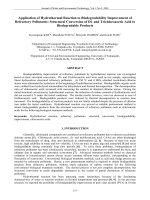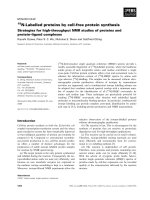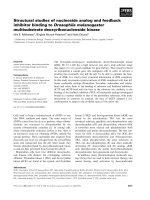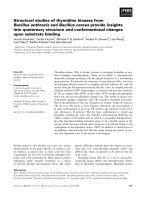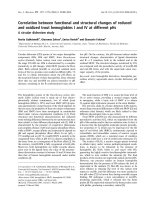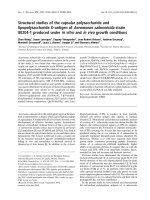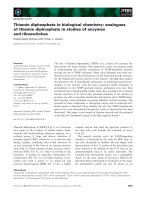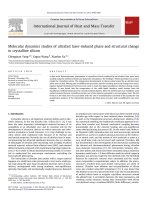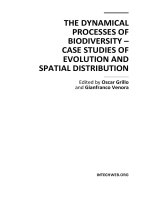Structural studies of cysteine and serine protease inhibitors towards therapeutic applications
Bạn đang xem bản rút gọn của tài liệu. Xem và tải ngay bản đầy đủ của tài liệu tại đây (18.36 MB, 202 trang )
1
STRUCTURAL STUDIES OF CYSTEINE AND SERINE
PROTEASE INHIBITORS TOWARDS THERAPEUTIC
APPLICATIONS
RAJESH TULSIDAS SHENOY
(B.E)
A THESIS SUBMITTED FOR THE DEGREE OF
DOCTOR OF PHILOSOPHY
DEPARTMENT OF BIOLOGICAL SCIENCES,
FACULTY OF SCIENCE,
N
ATIONAL UNIVERSITY OF SINGAPORE
June
200
9
2
To my dear parents
3
Acknowledgements
I am grateful to
A/P
J Sivaraman who has been my mentor
during
four and a half years
of my PhD course. He has always been approachable and ex
tremely patient with me. He
has provided me with a strong footing in protein crystallography and biological research
in general. His vast experience in the field of cysteine proteases has nurtured my interest
to work on human Cathepsin
-
L which is one of th
e important drug development targets.
I am thankful to Prof. Ding Jeak Ling, for having provided me the opportunity to work on
the exciting topic of
serine protease inhibitors in the
innate immunity of the horseshoe
crab which has constantly fuelled my
passion in my work.
I thank Prof RM Kini for his
support and encouragement.
I would like to thank
P
r
of
. Enrico Purisima, Dr. Shafinaz
Chowdhury, Dr. Adrian Velazquez for their invaluable contribution
to the
projects. I am
grateful to
my
Lissa Joseph
and
D
r. Sundramurthy Kumar and who have worked
in
the
projects and made my work enjoyable.
I would like to thank Dr Anand Saxena and Dr J
Seetharaman who helped me during my
data collection at National Synchrotron Light
Source, USA.
I am
grateful
to
Thangavelu
, Pankaj Kumar Giri and Manjeet for helping
me with my thesis proof
reading and final experiments. I am grateful to A/P K
Swaminathan and all members of his lab, especially Dileep Vasudevan, Shiva Kumar,
Kuntal Pal, for their support. I am thankful to Dil
eep. G. Nair and Tzer Fong for their
help and support. I would like to thank all my labmates for their help and support
especially, Jobichen Chacko and Sunita.
Finally I thank
National Universi
ty of Singapore
for
providing an
intellec
tually stimulating env
ironment
and all the resources to make this
work possible.
I offer my special thanks to my parents, who constantly encouraged me
4
throughout my life in all my endeavors. Without their support this work would not have
been possible.
5
Tabl
e of
Contents
Page
Acknowledgments
iii
Table of contents
vi
Summary
x
List of tables
xiii
List of figures
xv
List of abbreviations
xxi
Publications
xxiv
6
Page
Chapter I
: General Introduction
1
1.
1
Classification and Nomenclature of Pro
teases
2
1.2 Levels of Classification
5
1.2.1 Catalytic types
5
1.2.2 Molecular Structures
7
1.2.3 Individual Peptidase
8
1.3
Role of the proteases in diseases
9
1.3.1 Cysteine proteases
10
1.3.2 Catalytic mechanism of cysteine proteases
14
1.3.3 Inhibitors of Cysteine proteases
16
1.3.4 Endogenous inhibitors: Cystatin superfamily
16
1.3.5 Synthetic inhibitors of Cysteine proteases
17
1.4 Serine proteases
22
1.4.1Catalytic mechanism of Serine proteases
23
1.4.2 Serine protease inhibitors
26
1.4.3 Serpins
27
1.4.4 Canonical serine protease inhibitors
29
1.4.5 Non canonical serine protease inhibitors
31
1.4.6 Synthetic inhibitors of serine proteases
31
7
Page
Chapter II
:
Propeptide Mimetic Inhibitor Complexes
of Human Cathepsin L
35
2.1 Introduction
36
2.2 Experimental
37
2.2.1 Co
-
crystallization and D
ata collection
38
2.2.2 Structure Solution and Refinement
40
2.3 Results and Discussion
41
2.3.1 Structure of inhibitor 2 and Cathepsin L complex
41
2.3.2 S3
' Subsite
47
2.3.3 Electrostatics of the S1
' Subsite
48
2.3.4 Design of dimer
-
mimetic propeptide inhibitors
49
2.3.5 Str
ucture of the dimer
-
mimetic propeptide inhibitor complexes
50
2.3.6 Inhibitor 4
50
2.3.7 Inhibitor 9
57
2.3.8 Inhibitor 14
62
2.3.9 Molecular Dynamics
67
2.4 Conclusion
72
8
Page
Chapter III
:
Cryst
al Structures of Human Cathepsin L
Complexed with a Peptidyl Glyoxal Inhibitor
and a
Diazomethylketone Inhibitor
74
3.1 Introduction
75
3.2 Materials and Methods
77
3.2.1 Crystallization and data collection
77
3.2.2 Structure Solution and Refinement
79
3.3 Results and Discussion
79
3.3.1
Z
-
Phe
-
Tyr(OBut)
-
COCHO : Cathepsin
-
L complex
80
3.3.2 Z
-
Phe
-
Tyr (
t
-
Bu)
-
DMK: Cathepsin L complex
90
3.4 Conclusion
102
Chapter IV: Structural basis for a non
-
classical Kazal
-
type
serine protease inhibitor
in regulating
host
-
pathogen
interaction via a dual
-
inhibition mechanism
104
4.1 Introduction
105
4.2 Experimental
109
4.2.1 Expression, purification, crystallization and
structure determination
109
4.2.2 Structure Solution and Refinement
111
4.2.3
Isothermal Titration Calorimetry (ITC)
113
4.2.4 Inhibition of Furin by CrSPI
-
1
114
4.3
Results and Discussion
114
4.3.1 Overall structure
114
4.3.2 Structure of CrSPI
-
1
120
9
Page
4.3.3 rCrSPI
-
1: subtilisin complex
124
4.3.4 CrSPI
-
1 RSLs interactions wi
th subtilisin
126
4.3.5 Rigidity of the RSL
134
4.3.6 Specificity of CrSPI
-
1 domains
139
4.3.7 ITC Experiments with CrSPI
-
1
141
4.3.8 Experiments with peptide derived from CrSPI
-
1 domain 2
145
4.3.9 Implications for the possible dual functions of CrSPI
-
1
147
Chapter V: Conclusions and Future Directions
153
5.1 Conclusions
154
5.2 Future directions
156
References
158
10
Summary
Proteases play a very important role in a multitude of physiological reactions such
as cell signaling, migration, immunological defense, wound healing and apoptosis a
nd are
crucial for disease propagation. Of the over 400 known human proteases, around 14% are
under investigation as drug targets and the proportion is expected to increase considerably.
The study of proteases and protease inhibitors are emerging with prom
ising therapeutic
uses. In this study we have selected the cysteine and serine protease inhibitor complexes to
understand their inhibition mechanisms. Both proteases share similar catalytic triad
(example: Subtilisin Asp32
-
His64
-
Ser221; Papain Cys25
-
His15
9
-
Asn175). Further, the
nature of oxyanion hole found in cysteine proteases of papain super family is similar to that
found in subtilisin. In addition, many of these proteases are secreted as inactive forms
called zymogens and subsequently activated by pro
teolysis, thereby changing the
architecture of the active site of the enzyme.
This
PhD
thesis
consists of
five chapters. Chapter I deals with the literature survey
and general introduction for both cysteine and serine proteases and their inhibitors. Chapte
r
II deals with the inhibitor complex studies with human cathepsin L.
Cathepsin L
plays a
vital role in many pathophysiological
conditions
including
rheumatoid
arthritis,
tumour
invasion and metastasis, bone resorption and remodeling.
In
this chapter
we re
port a series
of noncovalent, reversible
propeptide mimic
inhibitors of cathepsin L that have been
designed to explore additional binding interactions with the S
’
subsites. The design was
based on
the
previously reported crystal structure that suggested th
e possibility of
engineering increased interactions with the S
’
subsites. A
few
representatives of these new
inhibitors have been co
-
crystallized with mature cathepsin L, and the structure
s have
been
11
solved and refined at
2.2,
2.5, 1.8 and 2.5Å
respectivel
y
.
These four inhibitors were
selected to help clarify and elucidate the binding mode of this class of inhibitors. Of
particular interest was the disposition of the biphenyl groups in the S’ subsites of the
enzyme since the addition of a second biphenyl gr
oup to the inhibitor does not improve
potency.
Th
es
e inhibitors described in this work extend farther into the S
’
subsites of
cathepsins than any inhibitors reported in the literature thus far. These interactions appear
to make use of a S3
’
subsite that can potentially be exploited for enhanced specificity
and/or affinity.
In collaboration with Prof Enrico McGill Uni
versity, Canada, w
e have also
carried out molecular dynamics simulations to supplement the information provided by the
crystal structure studies and to explore the dynamical behavior of these inhibitors in the
active site.
Chapter III reports the crystal
structure of two
covalent
di
peptidyl inhibitors
in
complex with
human
Cathepsin
-
L
. These two inhibitors
hav
e
different
groups
in S1 subsite
such as inhibitor
1
with
α
-
keto
-
β
-
aldehyde and
inhibitor
2
with
diazomethylketone
. The
inhibitor
1
Z
-
Phe
-
Tyr (OBut)
-
COCHO
has a
Ki=0.6 nM
. It is the
most potent, synthetic
peptidyl
reversible
inhibitor of cathepsin L reported to date
.
The
co
-
crystal
structure of this
inhibitor
wi
th
human
Cathepsin
-
L
was refined upto
2.2Å
resolution
.
The inhibitor
2
Z
-
FY (
t
-
Bu)
-
DMK
,
an irreversible inhibitor which inactivates cathepsin L at
μM
concentrations has
been co
-
crystallized and the structure refined upto 1.7
Å
resolution. These inhibitors
h
ave
a
substrate
-
like interaction with the
active site
cysteine.
These structural studies, combined
with our previous complex structures of Cathepsin L reveal the structural basis for the
potency and selectivity of these inhibitors. Our studies on the cathe
psin inhibitor complexes
12
have the potential leading to further optimization of these inhibitors towards therapeutic
intervention.
Chapter IV deals with serine protease and its inhibitor complex.
Serine proteases
play a crucial role in host
-
pathogen intera
ctions. In the innate immune system of
invertebrates, multidomain protease inhibitors are important in regulating
host
-
pathogen
interactions and antimicrobial activities.
Serine
protease inhibitor
s (CrSPI
isoform
s
1 and
2
)
of 9.3 kDa
w
ere
identified
from
the
hepatopancreas of
horseshoe crab
,
Carcinoscorpius
rotundicauda
.
T
he CrSPIs were found to be biochemically active, particularly, the CrSPI
-
1
which potently inhibits
s
ubtilisin
(Ki=1.4
3
nM). Th
e
CrSPI has been grouped with non
-
classical Kazal
-
type inhibi
tors due to its unusual cysteine distribution.
Here we report the
2.6Å
r
esolution crystal structure of CrSPI
-
1
in complex
with
s
ubtilisin
and its biophysical
interaction studies
. The CrSPI
-
1 molecule consists
of
two domains arranged in an extended
conforma
tion
.
These two domains act as two heads to independently interact with two
separate subtilisin molecules resulting in the inhibition of subtilisin activity at a ratio of 1:2
(inhibitor: protease).
Each subtilisin molecule interacts with a reactive site lo
op of CrSPI
-
1
from each domain
through a standard canonical binding mode.
We show
how
such
multidomain inhibitors can
simultaneously inhibit
multiple
enzyme
s
within a single ternary
complex.
In addition we propose the substrate preference of the two domain
s of CrSPI
-
1.
Domain
-
2 is more potent and specific towards the bacterial protease subtilisin. Domain
-
1 is
likely to interact with the host protease, Furin, acting like an “
on
-
off
” switch in the
regulation of host’s and pathogen’s proteases. The structure o
f CrSPI
-
1
-
subtilisin ternary
complex will help to understand the innate immune system at a molecular level.
Chapter V
provides the overall conclusion and future directions of these projects.
13
List of Tables
Page
Table 1.
1
Classification of pr
oteases according to EC
Recommendations
6
Table 1.2
Classification of cysteine proteases
12
Table 1.3
Members of
the Lysosomal Cathepsins.
12
Table 1.
4
Calpain in Pathological Processes.
13
Table 1.5
Classification of enzyme inhibitors
18
Table 1.6
Clans
of Serine proteases classified based
on structural similarity in the MEROPS
database.
23
Table 2.1a
Inhibitor S
tructures co
-
crystallized with
Cathepsin
-
L
and their activities.
38
Table 2.1b
Crystallographic data and refinement statistics
for inhibitor
2
.
42
Table 2.2
Crystallographic data and refinement statistics.
51
Table 3.1
Crystallographic data and refinement statistics.
82
Table 3.2a
Hydr
ogen bonds formed by Inhibitor 1 in the
c
atalytic
cleft of Cathepsin L.
90
Table 3.2b
Hydrophobic contacts between Inhibitor 1 and
c
athepsin L
b
i
nding pockets.
90
Table 3.3a
Hydrogen bonds formed by Inhibitor
2
in
the catalytic
cleft of Cathepsin L.
97
Table 3.3b
.
Hydrophobic
contacts between Inhibitor
2
and
c
athepsin L binding pockets.
98
14
Page
Table 4.1.
Crystallographic data and refinement statistics.
116
Table 4.2.
Selected
hydrogen bonding contacts between
rCrSPI
-
1
domain
-
1 and subtilisin.
127
Table 4.3.
Selected hydrogen bonding contacts between
rCrSPI
-
1
d
omain
-
2 and s
ubtilisin.
130
Table 4.4.
Reactive site loop regions from P3 to P3’
position of
selected serine protease inhibitors.
132
Table 4.5.
Main chain torsion angles of
the reactive site
l
oops
of serine protease inhibitors complexed
with subtilisin.
134
15
List of figures
Page
Figure 1.
1
Classification of
proteases based on cleavage
4
specificity
Figure 1. 2
The three levels of classification of proteases
4
Figure 1.3
Clan of Aspartic Peptidases from the MEROPS
Database
8
Figure 1.4
Crystal structures of selected proenzyme and
m
ature
forms of Cathepsins
13
Figure 1.5
The catalytic mechanism of a cysteine protease
15
Figure 1.6
The catalytic triad of cysteine protease Papain
16
Figure 1.7
Acylation reaction in the catalytic mechanism
of a
serine protease
24
Figure 1.8
The deacylation reaction in the catalytic
mechanism of a
s
erine protease
.
25
Figure 1.9
The catalytic triad of serine proteases
26
Figure 1.10
Comparison of the four different conformations
of the serpin α1
-
proteinase inhibitor
.
28
Figure 1.11
Representative structures of selected canonical
s
erine
protease inhibitor families.
30
Figure 2.1
Simulated
-
annealing
F
o
-
F
c omit map in the
active
-
site
region of the cathepsin L inhibitor
complex.
43
Figure 2.2
Overlay of the 1MHW crystal structure and
44
the crystal structure of
2.
16
Page
Figure 2.3
Overlay of
2
with a diaminoketone inhibitor
46
Figure 2.4
Overlay of
2
with
a vinylsulfone inhibitor.
47
Figure 2.5
Overlay of
2
with a hypothetical polyalanine
substrate.
48
Figure 2.6
Stereo view of interactions between the inhibitor 4
and cathepsin L.
53
Figure 2.7
Schematic view of cathepsin L interactions with
inhibitor
4
.
54
Figure 2.8
Stereo view of the simulated annealing Fo
-
Fc
omit map in the active site region of cathepsin L.
55
Figure 2.9
Crystal packing interactions of two adjacent
protein
-
ligand
c
omplexes in the unit cell of
Inhibitor
4
and cathepsin L
complex.
56
Figure 2.10
Stereo view of interactions between the
inhibitor 9 and cathepsin L.
58
Figure 2.11
Schematic view of cathepsin L interactions
with inhibitor
9
.
59
Figure 2.12
Stereo view of the simulated annealing Fo
-
Fc
omit map in the active site region of cathepsin L.
61
Figure 2.13
Cryst
al packing interactions of two adjacent
protein
-
ligand complexes in the unit cell of
Inhibitor
9
and cathepsin L
complex.
62
Figure 2.14
Stereo view of interac
tions between the
inhibitor
14
and
cathepsin L.
64
Figure 2.15
Schematic view of cathepsin L interactions
with inhibitor
9
.
65
17
Page
Figure 2.16
Stereo view of the simulated annealing
Fo
-
Fc omit map
in the active site region
of cathepsin L.
66
Figure 2.17
Interatomic distance fluctuations involving
inhibitor
4
.
68
Figure 2.18
Interatomic distance fluctu
ations involving
70
inhibitor
9.
Figure 2.19
Interatomic distance fluctuations involving
inhibitor
1
4
.
7
1
Figure 2.20
Snapshot of MD
-
refined structure of
inhibitor
4
.
72
Figure 3.1a
Chemical reaction between
Z
-
FY(t
-
Bu
)
-
COCHO(inhibitor
1
) and
81
Figure 3.1b
Crystal structure of the molecule showing
inhibitor
1
in
the active site of Cathepsin L
displayed in surface
representatio
n.
84
Figure 3.1c
Crystal structure of the molecule showing
inhibitor
1
in
the active site of Cathepsin L
displayed in cartoon representation
.
85
Figure 3.2a
Interactions made by inhibitor 1 in the
catalytic cleft
of Cathepsin L.
86
Figure 3.2b
Schematic view of cathepsin L interactions
with inhibitor
1
.
87
Figure 3.3
Final 2Fo
-
Fc electron density map for the
inhibitor 1 and its covalent attachment to
Cys25 of Cathepsin L.
89
Figure 3.4a
Chemical reaction between Z
-
FY(t
-
Bu)
-
diazomethylketone(inhibitor
2
)
and Cathepsin L.
91
18
Page
Figure 3.4b
Crystal structure of the molecule showing
inhibitor
2
in
t
he active site of Cathepsin L
displayed in surfac
e representation.
93
Figure 3.4c
Crystal structure of the molecule showing
inhibitor
2
in the active site of Cathepsin L
displayed in cartoon representation.
94
Figure 3.5a
Interactions made by inhibitor 2 in the catalytic
c
left
of Cathepsin L.
95
Figure 3.5b
Schematic view of c
athepsin L interactions
with inhibitor
2
.
96
Figure 3.6
Final 2Fo
-
Fc electron density map for the
inhibitor
2
and its covale
nt attachment to
Cys25 of Cathepsin L.
97
Figure 3.7
Overlay of crystal structures of Cathepsin L
complexes with inhibitors 1 and 2.
99
Figure 3.8
Comparison of the geometries of hemithioacetal
formed in
i
nhibitor
1
with the thioester
formed with inhibitor
2
.
101
Figure 4.1
Alignment of amino acid sequences of
non
-
classical
group I Kazal
-
type inhibitors
108
Figure 4.2a
Stereo view of
2Fo
-
Fc
map for the react
ive site loop
region of domain
-
1 of rCrSPI
-
1 bound to subtilisin
112
Figure 4.2b
Stereo view of
2Fo
-
Fc
map for the reactive site
l
oop
region of domain
-
2 of rCrSPI
-
1
bound to
subtilisin co
ntoured at a level of 1σ.
113
Figure 4.3a
Structure of the rCrSPI
-
1
-
(Subtilisin)
2
complex.
117
Figure 4.3b
The CrSPI
-
1: Subtilisin complex.
118
19
Page
Figure 4.3c
T
he CrS
PI
-
1: Subtilisin complex. CrSPI
-
1 in
Surface r
epresentation and subtilisin is
in ribbon representation.
119
Figure 4.3d
Cα trace of rCrSPI
-
1.
121
Figure 4.4
Multiple sequence alignment for the representative
Members
of Kazal
-
type Non classical group I
proteinase inhibitors
.
121
Figure 4.5a
Stereo view of the Cα superposition of domain
-
1
and domain
-
2 of rCrSPI
-
1.
124
Figure 4.5b
Gel filtration profile of the CrSPI
-
1 Subtilisin
complex
t
ogether with subtilisin as a control
run on a Superdex 75 column.
125
Figure 4.5c
Nonreducing SDS gel of the CrSPI
-
1 Subtilisin
complex.
125
Figure 4.6a
Stereo view of the interactions between subtilisin
and the reactive site loop of domain
-
1.
129
Figure 4.6b
Stereo vi
ew of the interactions between subtilisin
and the
reactive site loop of domain
-
2.
131
Figure 4.7a
Conformations
of the reactive site loop
of domain
-
1
and domain
-
2 boun
d to subtilisin.
135
Figure 4.7b
Superposition of the reactive site loops of
domain
-
1,
domain
-
2, Eglin C.
136
Figure 4.8a
Isothermal Titr
ation Calorimetric curve for
rCrSPI
-
1 tit
rated against subtilisin
.
142
Figure 4.8b
Isothermal Titration Calorimetric curve
and binding
parameters for rCrSPI
-
1 titr
ated
against subtilisin.
143
20
Figure 4.9a
Isothermal Titration Calorimetric curve and
binding parameters for VCTEEY titrated against
subtilisin.
144
Figure 4.9b
Isothermal Titration Calorimetric curve and binding
parameters for VCTEEY titrated against subti
lisin.
145
Figure 4.10a
Model of Furin
-
rCrSPI
-
Subtilisin heterotrimer
complex.
147
Figure 4.10b
Cα trace for the heterotrimer Furin
-
CrSPI
-
Subtilisin
complex model.
149
Figure 4.10c
Surface representation for Furin and Subtilisin,
and ribbon representation for CrSPI
-
1 of the
heterotrimer
m
odel.
150
21
List of Abbreviations
Ǻ
Angstrom (10
-
10
m)
AEI
Anemonia elastase inhibitor
BME β mercaptoethanol
Boc
t
-
butoxycarbonyl
BPTI
Bovine Pancreatic Trypsin Inhibitor
Cbz
carboxybenzyl
CNS Crystallography and
NMR system
CrSPI
-
1
Carcinoscorpius
rotundicauda
serine protease
DLS
Dynamic Light Scattering
DMK
Diazomethylketone
DTT
Dithiothreitol
E.coli
Escherichia coli
EC
Enzyme Commission
EDTA
Ethylene
diamine tetraacetic acid
FPLC
Fast performance liquied chromatography
gel electrophoresis.
HEPES 4
-
(2
-
hydroxyethyl)
-
1
-
piperazineethanesulfonic acid
inhibit
or
-
1
IPTG Isopropyl thio
-
galactoside
22
ITC Isothermal Titration Calorimetry
kDa kilo Dalton
LB Luria
-
Bertani
LEKTI
lympho
-
epithelial Kazal
-
type inhibitor
MD
Molecular Dynamics
MES
2
-
(N
-
morpholino)ethanesulfonic acid
NCS
Non
-
crystallographic symmetry
Ni
-
NTA Nickel nitrilo
-
triacetic acid.
NMR
Nuclear magnetic resonance
OD
Optical density
OMSVP3
Silver pheasant
ovomucoid third domain
OMTKY3
Turkey ovomucoid third domain
PCR
Polymerase chain reaction
PDB
Protein Data Bank
PEG
polyethylene glycol
PSTI
Pancreatic Secretory Trypsin
Inhibitor
Rmsd
root mean square deviation
SDS
-
PAGE
Sodium dodecyl sulphate polyacrilamide
23
AminoAcids
Gly (G) glycine
Ala (A) alanine
Val (V) valine
Leu (L) leucine
Ile (I) isoleucine
Met (M) methionine
Phe (F) phenylalanine
Trp (W) tryptophan
Pro (P) proline
Ser (S)
serine
Thr (T) threonine
Cys (C) cysteine
Tyr (Y) tyrosine
Asn (N) asparagine
Gln (Q) glutamine
Asp (D) aspartic acid
Glu (E) glutamic acid
Lys (K) lysine
Arg (R) ar
ginine
His (H)
histidine
24
Publications
1.
Tulsidas, S.R
., Thangamani, S., Ho, B., Sivaraman, J.
and
Ding, J.L.
(2009).
Crystallization of a nonclassical Kazal
-
type Carcinoscorpius rotundicauda serine
protease inhibitor, CrSPI
-
1, complexed with subtilisin.
Acta Crystallogr Sect F Struct
Biol Cryst Commun
.
,
65
,
533
-
5.
2.
Chowdhury
,
S.F., Joseph, L., Kumar, S.,
Tulsidas
, S.R
.,
Bhat, S., Ziomek, E
.,
Nard, R.M., Sivaraman, J. and
Purisima, E.O.
(2008
).
Exploring inhib
itor binding at
the S
’
subsites of cathepsin L
.
J Med Chem
.
,
5
1
,
1361
-
8
.
3.
Shenoy, R.T
.
,
Chowdhury, S.F.
, Ku
mar
,
S.,
Joseph
, L.,
Purisima,
E.O.,
and
Sivaraman
, J. (2009).
A combined crystallographic and molecular dynamics study of
cathepsin L retro
-
bind
ing inhibitors.
J. Med. Chem
.
,
52
, 6335
–
6346
.
4.
Shenoy, R.T.
and
Sivaraman, J.
(2010).
Structural basis for reversible and
irreversible inhibition of human cathepsin L by their respective dipeptidyl glyoxal
and diazomethylketone inhibitors.
J Struct Bi
ol
.
,
173
,
14
-
9.
5.
Shenoy, R.T.,
Thangamani, S., Velazquez
-
Campoy, A., Ho, B. , Ding, J.L.
and
Sivaraman
, J. (20
10
).
Structural Basis for Dual
-
inhibition Mechanism of a Non
-
classical Kazal
-
type Serine Protease Inhibitor from Horseshoe Crab in Complex wi
th
Subtilisin
.
PLoS One
(accepted)
.
6.
Husain, N., Tkaczuk, K.L.,
Tulsidas, S.R.
, Kaminska, K.H., Cubrilo, S.,
Maravić
-
Vlahovicek, G., Bujnicki, J.M., Sivaraman, J.
(2010). Structural basis for the
methylation of G1405 in 16S rRNA by aminoglycoside resistance methyltransferase
Sgm from an antibiotic producer: a diversity of active sites in m7G
methyltran
sferases.
Nu
cleic Acids Res
.,
38
,
4120
-
32.
25
Chapter I
General Introduction
